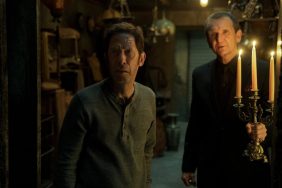A SXSW ’11 review

Directed by Sean Hogan, Andrew Parkinson, Simon Rumley
Review:
Although I’m certainly a fan of many filmmakers who have participated in them, I’ve never been a huge proponent of anthology horror films. Typically at best, there’s a segment or two that stands out conspicuously from the rest, but like any collaboration or partnership, most anthologies are only as successful as their least effective installments. Little Deaths is more a case of the former, although the difference between the “best” one and its almost-equal companion pieces is thankfully negligible; regardless, four-square and alt-horror fans alike will find much to like in these three stories from Simon Rumley, Andrew Parkinson, and Sean Hogan, as they offer more substantive fare even within the parameters of the film’s vignette format.
Sean Hogan opens the film with House & Home, about a married couple whose sexual appetites require the participation of a third party, although not necessarily a willing one. Hogan’s film is followed by Andrew Parkinson’s Mutant Tool, about the young, beleaguered girlfriend of a drug dealer, who begins experiencing strange visions after starting to take medicine from one of her boyfriend’s clients. And Simon Rumley’s Bitch offers a cathartic finale, painting a vivid portrait of a dysfunctional relationship that races towards the end of its rope â or in this case, its leash.
Hogan’s film is the most conventional of the three, and the producers made a smart decision showing his first, since comparatively speaking it eases audiences into the anthology’s overarching themes of sexuality and horror, rather than confronting them. But what’s most interesting about the film as a whole is how each filmmaker interprets and interpolates those themes into his own story; Hogan’s, again, is relatively straightforward, examining the visceral, while Parkinson’s gets into biological, and Rumley’s is almost purely emotional. In short, it’s a panoply of what contemporary horror both is and can be, suggesting that familiar conventions can still be reliable providers of thrills, but there’s plenty of room for folks to examine the outer edges of what’s been done and even uncover brand new territory.
While I enjoyed the first two, Rumley’s Bitch is the film that I feel proves the most transgressive; much like last year’s amazing Red White & Blue turned serial-killer conventions upside down, its tale of a disintegrating relationship taps into no less shocking but surprisingly more human dimensions of pain, both received and inflicted. In fact, Rumley’s film shares more in common with the works of folks like Catherine Breillat or perhaps even Gaspar Noe than any of his more immediate contemporaries, because it operates on a level not so removed from reality that its events couldn’t happen, and yet it seems outwardly heightened because the storytelling seems so concentrated and deliberate. Whether he becomes a more widely-recognized or commercial force in filmmaking remains to be seen, but Rumley carries the authority and integrity of a true visionary, and it will be interesting to see where he goes from here.
Of course, Parkinson and Hogan are equally promising, albeit in different ways: evidenced by their work here, Hogan has a gift for elegance and understatement even in the midst of monstrousness, and Parkinson’s aptitude for the slow-burn uneasiness of Cronenberg-style body horror heralds ever greater (and grosser) things in the future. But as a whole, Little Deaths is ultimately one of the best horror anthologies I’ve ever seen, not the least of which because it ignores the pretense of a framing device in favor of ideas that bind its segments more tightly together than a wraparound story ever could. And in that sense, it offers a two-for-one sort of satisfaction, because not only does it all work together as a whole, offering a solid and surprisingly cohesive collection of vignettes, but it announces not one but three formidable filmmakers, and offers ample evidence that all of them should be a big part of this genre’s future.










